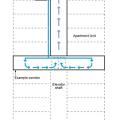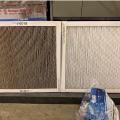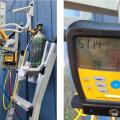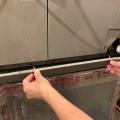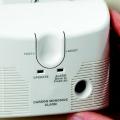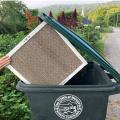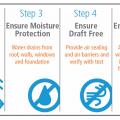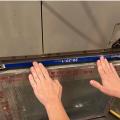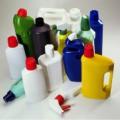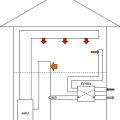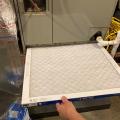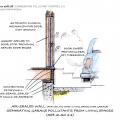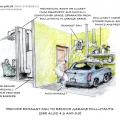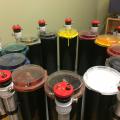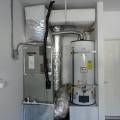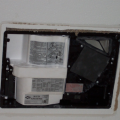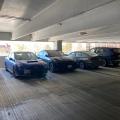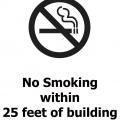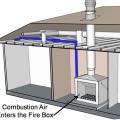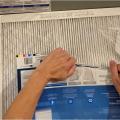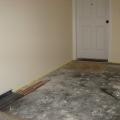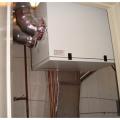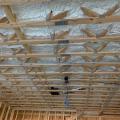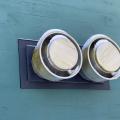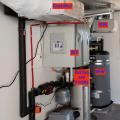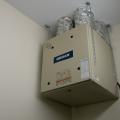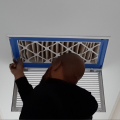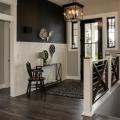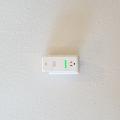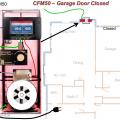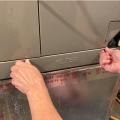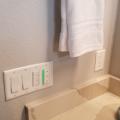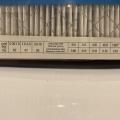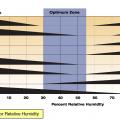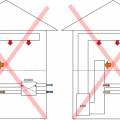Showing results 1 - 50 of 67
This central ventilation system uses an energy recovery ventilator to supply air to the corridor and exhaust air from the elevator shaft of a multifamily building
A comparison of a dirty furnace filter on left and clean filter on right. Dirty filters block airflow and make the furnace or air handler work harder.
A Corsi-Rosenthal Box is a highly effective DIY air cleaner made of easy to obtain materials such as HVAC filters, a box fan, cardboard, and tape
A nitrogen pressure test was completed on this ductless mini-split heat pump using a digital manifold gauge.
After inserting the new filter, replace the filter slot cover to minimize air leakage and heat loss.
Dispose of used filters in the garbage or purchase washable, reusable filters if desired and available for your furnace or air handler.
Equipment needed to pressure test the airtightness of walls separating the house from an attached garage
Follow these steps in home improvement projects to ensure safety and durability while maximizing comfort and energy efficiency
For better temperature distribution and air quality, every bedroom and all of the common spaces in this home have ducted returns to the central heat pump and all bathroom exhaust fans are controlled by a condensation sensor and timer switch.
Furnace filters come in many sizes; verify the correct size when purchasing for proper fit in the filter slot.
Gas sensors are used for gas leak detection and carbon monoxide detection
If integrating an ERV/HRV with the heating/cooling duct system, add dedicated ducts for either the supply or return side to prevent short-circuiting of air distribution
In this ventilation configuration for a multifamily building, outside air enters through a dedicated outdoor air system (DOAS), and inside air exits the space through bathroom and kitchen exhaust fans
Incorporating vestibules to separate the garage from interior occupied space can reduce the transfer of contaminants.
Insert the new furnace/air handler filter in the filter slot of the furnace or air handler with the arrow pointed in the direction of air flow.
Install a self-closing door with weatherstripping and thoroughly air-seal the shared house-garage walls to help keep automobile exhaust and other pollutants out of the home.
Installing a garage exhaust fan is one important step in keeping auto exhaust and other pollutants out of the home
It is not recommended to install HVAC systems in enclosed attached garages. However, when HVAC systems are installed in enclosed garages, they must comply with ASHRAE 62.2 duct leakage thresholds.
Lower-cost local ERVs are usually installed in a ceiling to supply outdoor air to and exhaust air from the room in which they are located
Mechanical exhaust is not required in this shared parking garage in a multistory multifamily building because the garage is not enclosed and can rely on natural air changes to reduce airborne contaminant concentration.
Remove the plastic wrap, but not the cardboard frame, before installing the furnace/air handler filter in the filter slot or above the return grate; note, the metal wire over the filter fabric can be very sharp.
Right - A stand-alone dehumidifier is located in the return air closet of this multifamily dwelling located in a humid climate
Right - Air-sealing the wall between the garage and the home is vital for occupant health and safety.
Right - Each individual unit in this multifamily building has its own energy recovery ventilator (ERV) to provide balanced ventilation to the dwelling
Right - The automated ventilation system has a sensor built in switch that can detect indoor air pollution; if it senses a rise in humidity, VOCs, smoke, carbon dioxide, or small particulates, the system will turn on the nearest fan to eliminate pollution
Right - The ceiling above the garage is insulated and air-sealed with open-cell spray foam to keep garage fumes out of the living space above.
Right - This enclosed parking garage in a multistory multifamily building is equipped with mechanical exhaust to remove airborne contaminants from the garage.
Right - This shared enclosed parking garage is equipped with exhaust fans to remove airborne contaminants from the garage.
Right – An air-to-water heat pump provides water and space heating while a heat recovery ventilator provides fresh air that is filtered by the HEPA filter.
Right – An HVAC contractor installs a 4-inch-thick MERV 13 filter at the intake grille of this return air vent to prevent dust, allergens, smoke, and viruses from entering the duct system.
Right – This home was constructed with no- or low-VOC paints, glues, flooring, cabinetry, and finishes that decrease indoor air pollutants in accordance with EPA Indoor airPLUS specifications.
Right – This HRV is ducted separately from the home’s ductless heat pumps to provide filtered fresh air to sleeping and living areas and to exhaust stale air from the bathrooms and laundry.
Right – This plug-in sensor detects indoor air quality issues in a home, including elevated levels of humidity, VOCs, smoke, carbon dioxide, or small particulates; if detected, the sensor can switch on the nearest exhaust fan to remove the pollutants.
The air tightness of the garage-to-house air barrier can be tested with a blower door kit and two manometers
The air tightness of the house-garage air barrier can be tested using a CFM50 test that is first run with the garage door to outdoors closed
The air tightness of the house-garage air barrier can be tested using a CFM50 test that is run first with the garage door to outdoors closed and then with the overhead garage door to outdoors open
The airflow direction is labeled on the edge of the filter to ensure it is properly oriented when installed.
The edge of this 1-inch HVAC filter indicates it's dimensions, allowing proper matching of filter to air handler
The furnace filter slot cover should fit tightly to minimize air leakage but it should not be taped or caulked to enable frequent filter replacements.
The green-lit panel next to the fan and light switches is an indoor air quality sensor that will automatically turn on the exhaust fan if it detects a rise in humidity or indoor air pollutants.
The MERV rating, particle capture efficiencies, and pressure drops are printed on the side of this 1-inch pleated filter
These ERV/HRV configurations are NOT recommended because outdoor air can be sucked back into the ERV/HRV before being distributed to the living space
These garages attached to multifamily townhouses are open to the exterior, allowing for natural air changes to remove airborne contaminants from the garage.
